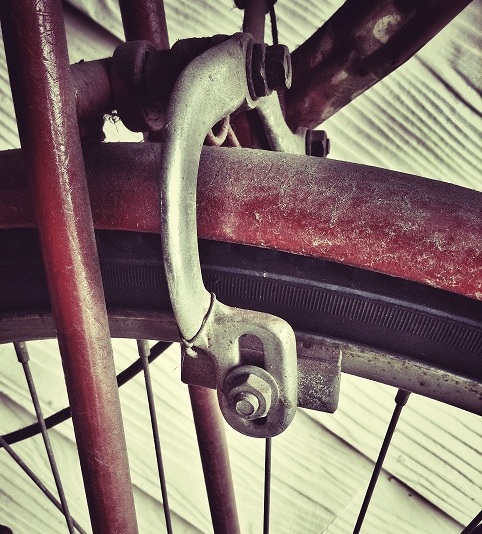Give Me a Brake!
 Lesson courtesy of IEEE’s Tryengineering.org. Click for .PDF)
Lesson courtesy of IEEE’s Tryengineering.org. Click for .PDF)
Grade level: 3 – 6
Time: 45 minutes
Summary
In this activity, student teams learn about force and friction by examining how basic rim bicycle brakes work and discussing the advantages of various designs. They then use low cost materials to devise a simple braking system, suggest improvements to current bicycle brake designs, and present their recommended changes to the class.
Learning Objectives/Outcomes
As a result of this activity, students should develop an understanding of:
- force and friction
- brakes
- the impact of engineering and technology on society
- engineering problem solving and the design process
- teamwork
Standards
National Science Education Standards
As a result of their activities, all students should develop an understanding of
- Motions and forces
- Transfer of energy
CONTENT STANDARD E: Science and Technology
As a result of activities in grades 5-8, all students should develop
- Abilities of technological design
- Understandings about science and technology
Next Generation Science Standards
Matter and its Interactions. Students who demonstrate understanding can:
- 2-PS1-2. Analyze data obtained from testing different materials to determine which materials have the properties that are best suited for an intended purpose.
Energy. Students who demonstrate understanding can
- 4-PS3-1. Use evidence to construct an explanation relating the speed of an object to the energy of that object
Engineering Design. Students who demonstrate understanding can
- 3-5-ETS1-1.Define a simple design problem reflecting a need or a want that includes specified criteria for success and constraints on materials, time, or cost.
- 3-5-ETS1-2.Generate and compare multiple possible solutions to a problem based on how well each is likely to meet the criteria and constraints of the problem.
- 3-5-ETS1-3.Plan and carry out fair tests in which variables are controlled and failure points are considered to identify aspects of a model or prototype that can be improved.
- MS-ETS1-2 Evaluate competing design solutions using a systematic process to determine how well they meet the criteria and constraints of the problem.
Internati0nal Technology and Engineering Educators Association
The Nature of Technology
Standard 1: Students will develop an understanding of the characteristics and scope of technology.
Standard 3: Students will develop an understanding of the relationships among technologies and the connections between technology and other fields of study.
Technology and Society
Standard 4: Students will develop an understanding of the cultural, social, economic, and political effects of technology.
Standard 7: Students will develop an understanding of the influence of technology on history.
Design
Standard 8: Students will develop an understanding of the attributes of design.
Standard 9: Students will develop an understanding of engineering design.
Standard 10: Students will develop an understanding of the role of troubleshooting, research and development, invention and innovation, and experimentation in problem solving.
The Designed World
Standard 18: Students will develop an understanding of and be able to select and use transportation technologies
Materials
For each student:
For each group of three to four students:
- marble or ball less than 1″ in diameter
- 1″ foam pipe insulation (foam) (about 12″) (available at hardware stores for less than $6 for whole class)
- cardboard tube from paper towels
- PVC pipe (about 12″)…similar diameter to towel tube
- string, rubber bands
Optional material – bicycle with working rim brake for examination.
1. Show students the various Student Reference Sheets. These may be read in class or provided as reading material for the prior night’s homework. They may also be directed to look at the brake systems on their own or a friend’s bicycle in advance of the activity.
2. Divide students into groups of 3-4 students; provide one set of materials per group.
3. Ask students to complete the student worksheet. As part of the process, the students work in teams as “engineers” to consider improvements to bicycle brake designs.
4. Each student group presents their vision of improved features for bicycle brakes to the class.
Additional resources
Computer Scientists Design Wireless Bike Brake. Oct 2011 CNET post describing a new system developed by German university researchers that does away with brake levers and messy wires.
International Bicycle Design Competition Yields Braking News. 2013 article on new brakes
How to adjust bike brakes. Basic look at bike brakes and changing worn-out brake pads. [YouTube 2:12]
How bike brakes work. Quick animation showing what happens when a hand brake is applied [YouTube 0:10]
Stanford engineering students build bikes from scratch. Article about an innovative Stanford engineering course.
Engineering students seek to design the world’s fastest bike. Feature story about a group of University of Toronto students and alumni from the July 2014 on eGFI students’ blog.
Filed under: Class Activities, Grades 6-8, Grades 6-8, Grades K-5, Grades K-5
Tags: bicycle, Class Activities, Design, Energy, Engineering Design, friction, gears, Grades 6-8, Grades K-5, Lesson Plan, motions and forces








